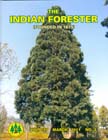Effect of Different Host Plants on the Development of Spilarctia obliqua Walk. (Lepidoptera: Arctiidae)
DOI:
https://doi.org/10.36808/if/2011/v137i3/12134Keywords:
Spilarctia Obliqua, Walk, Host Plants, DevelopmentAbstract
Spilarctia obliqua is a potential polyphagous pest of agroforestry importance which is capable to cause considerable damage to many forestry and agricultural crops in the absence of primary pest. Development of S.obliqua was studied by exposing larvae to main host plants including Brassica compestris, Paulownia fortunei, Populus deltoides, Tectona grandis and Toona ciliata. Total consumption of Toona ciliata foliage by the larvae was found maximum (6961.06mg) while that of Paulownia fortunei was minimum (3456.03mg). Taking consumption of average leaf area as the criteria, maximum leaf area of 13711.29mm2 of T. ciliata was found consumed while that of P. fortunei was minimum (7381.93mm2). Among the five host plants studied maximum weight (754.43mg) was gained by the larvae when fed on P. fortunei and minimum (390.93mg) on T. ciliata. Maximum larval length gain by the larvae was 45.46mm when fed on P. fortunei and minimum (29.19mm) on T. ciliata.Downloads
Download data is not yet available.
Downloads
Published
2011-03-01
How to Cite
Faisal, M., & Ahmad, M. (2011). Effect of Different Host Plants on the Development of <I>Spilarctia obliqua</I> Walk. (Lepidoptera: Arctiidae). Indian Forester, 137(3), 380–386. https://doi.org/10.36808/if/2011/v137i3/12134
Issue
Section
Articles
License
Unless otherwise stated, copyright or similar rights in all materials presented on the site, including graphical images, are owned by Indian Forester.





